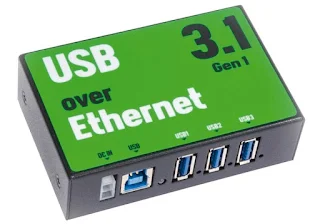Ethernet-Based USB Sharing: Bridging Connectivity
USB Over Ethernet allows users to connect to a USB device over a network connection. Users connect remotely to USB devices as if they were directly using the computer. This is a very convenient feature, especially if the user is far from the USB device.
Users can do a lot of different things using USB Sharing technology. Here are a few examples:
USB over Ethernet is valid for:
USB over Ethernet works with:
A USB device can be used on different OSes when the software is installed on one OS and connected to another. The USB over-network server is available for Windows, Linux, and macOS, and the USB over-network client is available for Windows and Linux.
How does USB over Ethernet work?
To start redirecting USB devices, the user needs to install USB over Ethernet on the computer to which the USB devices are physically connected. This will be the USB server. Next, the user must install USB over Ethernet Client, a free client application, on the computer the user wants to use USB devices remotely. Once everything is installed, you can share USB devices on the server and connect them to the client.
Sharing USB devices with multiple computers
With a USB remote connection, users can control their USB devices. They do not need to be physically present near the computer to connect or disconnect the device. Remote USB products appear as nodes on the user's local computer, allowing the user to view and manage them. Security is ensured by password authorization and traffic encryption.
Users can share USB devices over Ethernet or the Internet. It is straightforward:
After such actions, the user can connect all devices with installed software to the network.
Benefits of USB Over Ethernet technology
Using Share USB Over Ethernet has several advantages that make using this technology a good option in different situations:
USB Over Ethernet has many benefits, including remote access, cost savings, efficiency, flexibility, security, scalability, compatibility, ease of use, remote monitoring, and management. These benefits make it a valuable solution for businesses, education, and individuals who want to optimize USB device connectivity and improve productivity.
What can you do with USB over Ethernet?
Users can do a lot of different things using USB Sharing technology. Here are a few examples:
- Share USB storage data across all computers;
- Unlock multiple computers with one USB key;
- One Bluetooth or Wi-Fi dongle for any device that needs it;
- Sharing the printer with multiple computers;
- See what's happening on your connected webcam;
- One projector that can be used on any laptop with just one click;
- Use one keyboard and mouse for any computer.
USB over Ethernet is valid for:
- Software developers integrate USB over Ethernet functionality into their applications. The command-line interface allows USB devices to be shared and connected from within the application.
- Corporations and offices can access remote USB devices physically located in another office. This eliminates the need to purchase additional devices.
- Businesses where multiple users must use the same unique, heavy, or particular USB hardware. The device can be connected to the server's USB port in the server room while users use it one after another. There is no need to move the device.
USB over Ethernet works with:
- dongles;
- cell phones;
- webcams;
- audio devices;
- mass storage devices.
- printers, scanners, barcode readers, and almost any other USB device.
A USB device can be used on different OSes when the software is installed on one OS and connected to another. The USB over-network server is available for Windows, Linux, and macOS, and the USB over-network client is available for Windows and Linux.
How does USB over Ethernet work?
To start redirecting USB devices, the user needs to install USB over Ethernet on the computer to which the USB devices are physically connected. This will be the USB server. Next, the user must install USB over Ethernet Client, a free client application, on the computer the user wants to use USB devices remotely. Once everything is installed, you can share USB devices on the server and connect them to the client.
Sharing USB devices with multiple computers
With a USB remote connection, users can control their USB devices. They do not need to be physically present near the computer to connect or disconnect the device. Remote USB products appear as nodes on the user's local computer, allowing the user to view and manage them. Security is ensured by password authorization and traffic encryption.
Users can share USB devices over Ethernet or the Internet. It is straightforward:
- You need to connect a USB device to the USB port;
- Install the software on the server computer and remote computers;
- Configure both devices.
After such actions, the user can connect all devices with installed software to the network.
Benefits of USB Over Ethernet technology
Using Share USB Over Ethernet has several advantages that make using this technology a good option in different situations:
- With USB, users can remotely connect to their USB devices via the network/Internet. This helps you access devices that are not easily portable. Connecting a physically present device in the user's home or office is safe and secure.
- Remote USB connection saves costs by sharing expensive USB devices with your organization's employees. There is no need to purchase additional equipment. Users can share remote USB over the network and reduce costs.
- All types of USB devices, such as scanners, printers, communication devices, storage devices, user interface devices, video, audio, manufacturer-specific devices, etc., can be shared and accessed.
- A remote connection is an easy-to-use and stable solution for accessing USB devices.
- Devices can be configured to automatically share as soon as they are connected or during server startup. There is also an option to share all newly connected devices.
- Users can use the Don't Share This Device feature to prevent users from accidentally sharing a device (such as the system's primary USB mouse or keyboard).
- IP filters can block or allow only selected clients on the network to connect to the server.
- The USB Device Sharing Client supports callback connections from the server. This feature is useful when the server is behind a router or firewall and cannot accept incoming connections.
USB Over Ethernet has many benefits, including remote access, cost savings, efficiency, flexibility, security, scalability, compatibility, ease of use, remote monitoring, and management. These benefits make it a valuable solution for businesses, education, and individuals who want to optimize USB device connectivity and improve productivity.













Comments